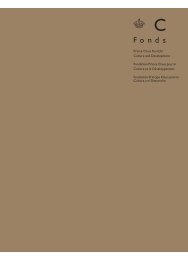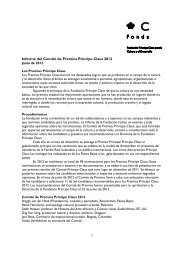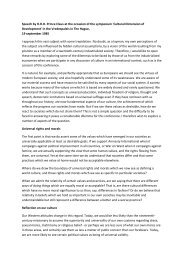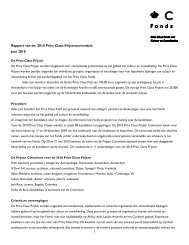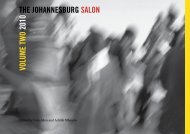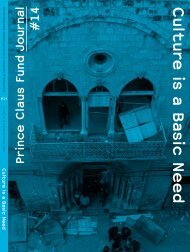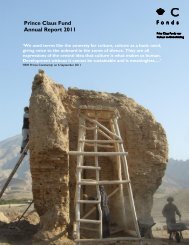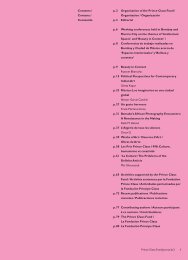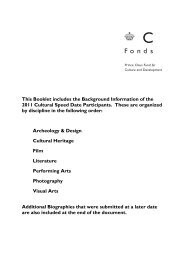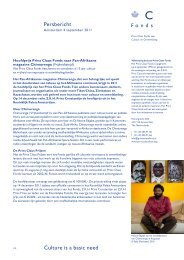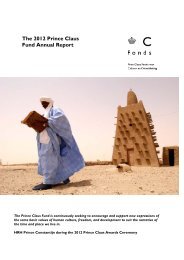3 summer 2011 - Prince Claus Fund
3 summer 2011 - Prince Claus Fund
3 summer 2011 - Prince Claus Fund
- No tags were found...
You also want an ePaper? Increase the reach of your titles
YUMPU automatically turns print PDFs into web optimized ePapers that Google loves.
0–053talattekin_alt:turklergaram 29.11.2007 9:21 Uhr Seite 41Chinese characters appearon one side of the BilgeKagan stone, from theOrkhon River Valley,Mongolia.Men sizben koştaskalı keldim “I’ve come to say good-bye”; Olawruw; sondıktan jumıs istemeydi “He’s ill; that’s why he isn’tworking.”D. The Karakalpaks and Their LanguageMost of the Turkic people of Kipchak origin known as theKarakalpaks today live in the Karakalpak Autonomous Republicwithin Uzbekistan, while smaller Karakalpak communities livein Khwarezm and Fergana Provinces in Uzbekistan, TashavuzProvince in Turkmenistan, various parts of Kazakhstan, andAstrakhan Province in the Russian Federation. According to the1989 census, the number of Karakalpaks in the former SovietUnion amounted to 423,436. To this should be added the smallKarakalpak community in Afghanistan.The Karakalpaks are Sunni Muslims. Karakalpak is oneof the written languages that emerged following the Soviet revolution.Until 1924, Karakalpak was written with the Arabicalphabet. Between 1928 and 1940, it used a Latin alphabet;since 1940, it has used an alphabet based on Cyrillic.Karakalpak is so close to Kazakh as to be considered a dialectof the latter. The main distinguishing features are the following:1. While in Kazakh the initial /y/ changes to /j/, in theKarakalpak dialect it changes to /c/: Kazakh jas = Karakalpakcas “young,” Kzk. jıl = Kklp. cıl “year,” Kzk. jol = Kklp. col “road,”Kzk. jigit = Kklp. cigit “young,” etc.2. While in Kazakh the initial /l/ after certain soundschanges to /t/ and /d/, it is preserved in the Karakalpak dialect:Kzk. atta- = Kklp. atla- “to step,” Kzk. attı = Kklp. atlı, Kzk. kızdar= Kklp. kızlar, Kzk. tister = Kklp. tisler “teeth,” etc.3. While in Kazakh the initial /t/ is preserved, inKarakalpak it changes, in certain words, to /d/: Kzk. tiz- = Kklp.diz- “to arrange,” Kzk. tize = Kklp. dize “knee,” Kzk. tuman =Kklp. duman, Kzk. tuz = Kklp. duz “salt,” Kzk. tüz- = Kklp. düz-“to organize,” etc.4. While in Kazakh the palatal /k/ at the beginning of aword is preserved, in the Karakalpak dialect it changes to /g/in certain words: Kzk. kez- = Kklp. gez-, Kzk. küzet- = Kklp.güzet- “to protect,” Kzk. kümis = Kklp. gümis “silver,” Kzk. küz= Kklp. güz, Kzk. küres = Kklp. güres “war,” etc.These and other differences are merely differences indialect rather than language. This can be easily understood inthe light of a few sentences with their Kazakh equivalents: Kklp.Ağaynim, men bunı tüsinbeymin = Kzk. Ağaynım, men munı tüsinbeymin“My friend, I don’t understand that”; Kklp. Bunı islepülgere almaspanba dep korkaman = Kzk. Munı istep ülgerealbaspınba dep korkamın “I’m afraid I may work and not succeed”;Kklp. Ol nawkas; sondıktan da islemeydi = Kzk. Ol, awruw;sondıktan da istemeydi “He’s ill; that’s why he isn’t working”;Kklp. Onı heş närse kızıktırmaydı = Kzk. Onı eş zat kızıktırbaydı“Nothing interests him”; Kklp. Sen bul tuwralı esitpeding be? =Kzk. Sen bul tuwralı estimep pe eding? “Haven’t you heard anythingabout it?”E. The Nogays and Their LanguageLike the Kazakhs, the Nogays are a people of mixedTurkic and Mongol extraction formed within the community ofthe Golden Horde. At the present time, the great majority of theNogays live in the Stavropol province of North Caucasia andthe autonomous region of Karachay-Circassia. There are alsosmall Nogay communities in Astrakhan and the AutonomousProvince of Daghestan. According to the 1989 census, therewere 75,564 Nogays living in the former Soviet Union. TheNogays are Sunni Muslims. The written form of Nogay thatemerged after the Soviet revolution was very similar to Kazakh,and the two languages possess a number of common features.For example, the changes of ş > s and ç > s in Kazakh can alsobe found in Nogay: bas “head,” kıs “winter,” kisi “person,” şıgar-“to extract, to take out,” keş “evening,” etc. Nevertheless, in certainfeatures, Nogay differs from Kazakh:1. The most important feature distinguishing Nogayfrom Kazakh is the preservation of the initial /y/: Nogay yas“young” (Kazakh jas), Nog. yasıl “green” (Kzk. jasıl), Nog. yasır-“to hide” (Kzk. jasır-), Nog. yawlık “handkerchief” (Kzk. jawlık),Nog. yemis “fruit” (Kzk. jemis), etc.2. Another characteristic feature of Nogay is thechange, as in Bashkir, of the initial /c/ in Arabic-Farsi borrowingsinto /y/: Arabic cawa:b > Nogay yawap “answer,” Farsi ca:n> Nogay yan “heart,” Arabic cennet > Nogay yennet, Arabiccum’a > yuma, Farsi cawa:nmard > *co:mart > yumart “generous,”etc.3. Another feature distinguishing Nogay from Kazakh isthe formation of the future tense in Nogay by means of the suffixes-ayak/-eyek: barayakpan “I will go,” bereyeksing “you willgive,” şabayak “he/she will run,” etc.A few sentences in Nogay: Men tangla bararman “I’mgoing to go tomorrow”; Taw tawga yolıkpas, ädem ädemge yolıgar“Mountains don’t meet; men do”; Erten barayakpan em yıyıneteyekpen “I will leave early, and have a meeting”; Men barayakekenmen, mutıp kaldım “I would go, but I forgot”; şaşuwdı songgakaldıruwşı bir kolhoz da bolmawga kerek “No kolkhoz [collectivefarm] should postpone the harvest till later.”F. The Kumuks and Their LanguageKumuk, which belongs to the koş- subgroup of theKipchak group of Turkic languages, is spoken mainly in theAutonomous Daghestan Republic attached to the RussianFederation, with its capital at Mahachkala. According to the1989 census, the number of Kumuk speakers was 282,178.The Kumuks are Sunni Muslims. Kumuk emerged as awritten language after the Soviet revolution. Kumuk was writtenin an Arabic alphabet from 1921 to 1928 and in a Latinalphabet from 1928 to 1938. Since 1938, it has been written ina Cyrillic alphabet. There are three dialects of Kumuk: (1) TheNorthern (Hasav-yurt) dialect, (2) the Central (Buynak) dialect,(3) the Southern (Haydak) dialect. The written language isbased on the Buynak dialect.The most important of the features of Kumuk commonto the Kipchak group of Turkic dialects is the change of /€/ and/g/ sounds in the middle and ends of words into /w/: ağır >awur, ağrığ > awruw “pain,” arığ > aruw “clean,” tağ > taw, ketig> ketüw “going,” säbig > süyüw “love,” etc.The change of g to y in the middle or at the end of a wordis one of the features common to the Kipchak group of Turkiclanguages: bäg > biy “Sir, Mr.,” äg- > iy- “to bend,” ägir- > iyir-“to spin,” kigür- > kiyir- “to insert,” täg- > tiy- “to touch,” tüg-> tüy- “to knot,” etc. Following are features peculiar to Kumuk:PRESENT-DAY TURKIC PEOPLES AND THEIR LANGUAGES4151 · <strong>Prince</strong> <strong>Claus</strong> <strong>Fund</strong> Reader #3 · Summer <strong>2011</strong>



